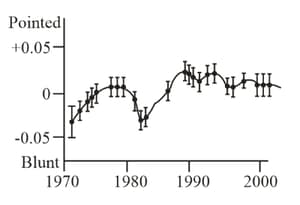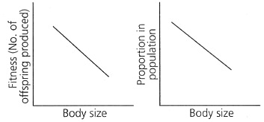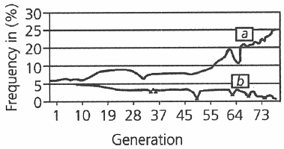Subject Experts Solutions for Exercise 2: HOTS HIGHER ORDER THINKING SKILLS
Subject Experts Biology Solutions for Exercise - Subject Experts Solutions for Exercise 2: HOTS HIGHER ORDER THINKING SKILLS
Attempt the free practice questions from Exercise 2: HOTS HIGHER ORDER THINKING SKILLS with hints and solutions to strengthen your understanding. MTG OBJECTIVE NCERT AT YOUR FINGERTIPS BIOLOGY CLASS XI + XII solutions are prepared by Experienced Embibe Experts.
Questions from Subject Experts Solutions for Exercise 2: HOTS HIGHER ORDER THINKING SKILLS with Hints & Solutions
In order to build a longitudinal dataset, data of adult finches Geospiza fortis living on one of the Galápagos Islands were collected. The beak shape data collected between 1971-2001 are shown in the graph.

Study the graph and select the correct statement.
The following summaries describe some published research results.
Research 1. Wu and Li (1985) : The comparative analysis of homologous genes between human and mouse genomes suggests that the evolutionary rate of homologous genes was higher in the mouse lineage than in the human lineage.
Research 2. Smith and Donohue (2008) : The plant families Caprifoliaceae, Asclepiadaceae and Lamiaceae are composed of both herbaceous and arborescent species. The comparative analysis of homologous genes between the herbaceous and arborescent species within a single plant family suggests that the evolutionary rate of homologous genes in herbaceous lineages were faster than that of arborescent lineages in all three plant families.
Research 3. Gilman et al. (2009) : The comparative analysis of 130 homologous mitochondrial genes between a sister species pair of vertebrates from the temperate region and from the tropical region indicate that the base substitution rates of homologous genes from the tropical region are 1.7 times faster than that of the temperate region.
Based on these studies, which of the following statements best describes the common evolutionary processes in plant and animal genes?
Mark the correct graph that represents the type of selection that this population is likely to undergo.

Study the characteristic of a population represented in the graph below:

Which type of selection, this population is likely to undergo?
Following table shows data on amino acid substitution in the chain of haemoglobin in four different mammalian species A, B, C and D. On the basis of the data shown in the table, choose the most appropriate evolutionary tree from those given below.
|
Comparison of Species |
Number of Amino Acid Substitution |
| A and B | 19 |
| B and C | 26 |
| A and C | 27 |
| D and C | 27 |
| A and D | 20 |
| D and B | 1 |
In a long term experiment on a population of Drosophila melanogaster, the frequency of two alleles 'a' and 'b' of a multi-allelic locus X over time has been shown in the following graph.

6 students were asked to evaluate the observed pattern and their inferences are given below.
Student 1: Environment is not uniformly selective.
Student 2: Population may be under artificial selection.
Student 3: Genetic variability is progressively reduced.
Student 4: Genetic variability is progressively increased.
Student 5: Mechanism such as genetic drift is operating from time to time.
Student 6: Selection is favouring a particular genotype through directional selection.
The appropriate conclusions were drawn by
**Formatting error resolved. Scientific name was changed in Italics.**
In a large, randomly mating population, only one person in 10,000 is an albino. What will be the frequency of a carrier person of albinism?
